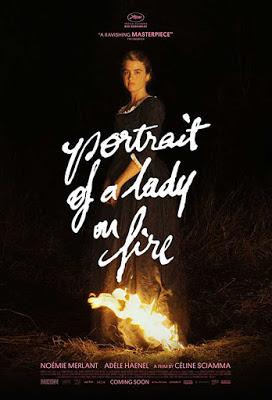
Céline Sciamma’s Portrait of a Lady on Fire may be described by some as a feminist film that tells a tale of four women characters in 18th century France devoid of any significant male characters, and made by a female director and a female cinematographer.At the end of this remarkable film, you tend to discount the female element. You are stunned by the sophisticated quality of cinema the film offers that makes you discount the overwhelming female gender quotient. The following two citations of awards bestowed on Sciamma’s Portrait of a Lady on Fire amply describe the worth of the film.
"The Gold Hugo for Best Film goes to Portrait of a Lady on Fire by Céline Sciamma. The film portrays not only the exuberance of falling in love and the all-consuming nature that is love, but also the beauty of women's solidarity and the attempt to fit in a world that rarely seems to be made for them. The strength of the filmmaking combined with amazing acting, photography, and music set the jury on fire."(Citation for the Best Film Award at Chicago International Film Festival.)
"This is a work, which excels in its audio-visual storytelling. Channelled through a strong female voice, it is at once narratively compelling and aesthetically striking. The film transports us to an age even more firmly in the grip of men than our own, to tell the tale of a handful of women. We follow their fascinating and deeply moving story, as they find intimacy and succour in one another, and a way to live out their dreams of freedom and fulfilment, to satisfy the longing to be a complete human being. In keeping with the best of period drama, our winner speaks to timeless human themes in a rich and stylistically self-assured visual register. With elegance, sophistication and courage, the film explores how love and vitality can - at least momentarily - throw off the shackles of an oppressive social order. Exquisite acting performances and cinematography, combined with a soupcon of mythological symbolism, add up to a work of serious artistic merit."(Norwegian film critics award citation.)
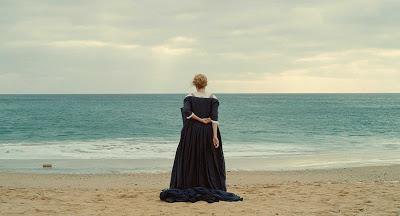
Héloïse (Adèle Haenel) is an enigma in the early parts of the film,
not suicidal but enjoying her freedom to run to the edge of the sea
after her long years in the nunnery
Sciamma’s original tale of Portrait of a Lady on Fire is of a female painter Marianne (Noémie Merlant) contracted by a countess (Valeria Golino) to paint a portrait of her second daughter Héloïse (Adèle Haenel) on an island in Brittany, France. The portrait is intended to be a wedding gift for Héloïse’s impending marriage to a wealthy man in Milan, who was earlier meant to marry Héloïse’s sister who suddenly died before the marriage could take place. Héloïse, we learn, was recently brought by her mother to the island from a nunnery where she was educated by the nuns. Héloïse, we further learn as the film progresses, is not looking forward to the prospect of her impending marriage and has deliberately disfigured an earlier portrait of her done by another painter for her impending wedding and has subsequently become a recluse with only Sophie (Luàna Bajrami), the maid, as her regular contact. Therefore, the countess briefs her newly hired painter Marianne that she has to paint her daughter Héloïse’s portrait without letting her know that her portrait is being painted and without revealing that Marianne is actually an artist commissioned to paint her portrait and not a mere hired companion for Héloïse, the official excuse for herpresence on the island.Sciamma’s screenplay, in the early stages, focuses on Marianne’s intense creativity as a portrait painter in capturing the features of her subject first in her memory only to paint the portrait in secret, which she does in the absence of her subject. Héloïse. in turn. is surprised why Marianne is looking at her so attentively.The entire process is cleverly captured on film by lady cinematographer Claire Mathon.In this process, director and screenwriter Sciamma and cinematographer Mathon make the viewer fall in love with the duo on screen, with minimal dialog spoken between the two characters. Sciamma and Mathon are the true “painters” in the film!
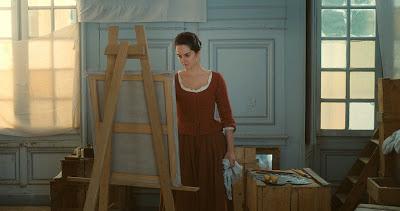
Marianne (Noémie Merlant) paints the portrait of Héloïse
from memory of the details she found while staring at her
The minimal dialog in the film’s script can be assessed by the fact that Héloïse’s name in the film is revealed only halfway into the film. Early in the film, as Marianne is transported by boat to the island her crate of canvas sheets falls into the sea and Marianne jumps into the sea to retrieve it. Initially the viewer would tend to consider it as Sciamma’s design to introduce and develop Marianne’s character. On deeper reflection, Sciamma’s script and direction add another aspect to that scene: the fact that no male person on the boat bothered to jump into the sea to retrieve the floating crate.
Having introduced the psychological development of interest between Marianne and Héloïse, Sciamma moves on to introduce the physical and, ultimately, to the emotional interest that develops between the two ladies with time. A key element used by Sciamma to aid this development is music, carefully but sparingly used. Héloïse, in the nunnery, had been exposed to choir singing and organ music. Little else. Marianne introduces Héloïse to harpsichord and Vivaldi’s compositions.Music is used in key sequences with elan. During the bonfire sequence, when Héloïse’s dress catches fire literally and figuratively, the women around the bonfire sing a cappella song. The final sequence in the film and definitely strongest in the entire film is that of the married Héloïse listening to Vivaldi’ssecond concert “Summer” in his famous four part concerti composition The Four Seasons. One can anticipate that over time that the ending will count as one of the most evocative film endings in the history of film, combining the effects of good scriptwriting, camerawork, direction and performances of the key actors without a word spoken.
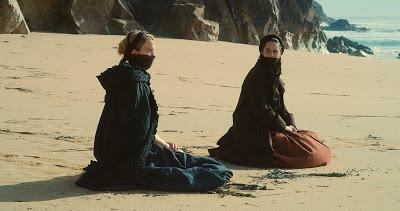
The stares for a professional cause that kick off a vibrant relationship
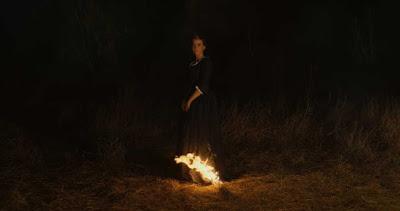
The fire is real, but the fire in the film's title is metaphorical.
Cinematographer Claire Mathon captures the rare moment
as the painter Marianne will recall the magical moment
Sciamma’s intelligent script suggests parallels with the mythological tale of Orpheus using music to lure his wife Eurydice back from the dead (the nether world of Hades) with a condition made by the gods that the Orpheus does not look at his wife. In the film Portrait of a Lady on Fire, the married Héloïse does not appear to look at Marianne while listening to a Vivaldi concert, music that Marianne hadmade Héloïse appreciate prior to her marriage.
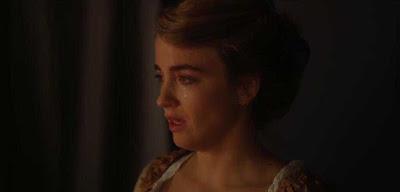
Héloïse discovering new aspects of life from Marianne: music.
love, painted images, impending marriage,,
There is a sub-plot of the maid Sophie finding out she is pregnant out of wedlock and the subsequent secret abortion conducted by Marianne and Héloïse, when abortion was illegal in the 18th century France.The role of the countess stresses another typical type of strong-willed woman in those times in France.Portrait of a Lady on Fire uses the four female characters developed and presented by a predominantly women crew, each of the four characters contrasting and complementing the other. Whether one likes the subject of Portrait of a Lady on Fire is personal choice but most viewers would appreciate the high quality of filmmaking on display.It is a film that distantly recalls Peter Greenaway’s 1982 film The Draughtsman’s Contract.
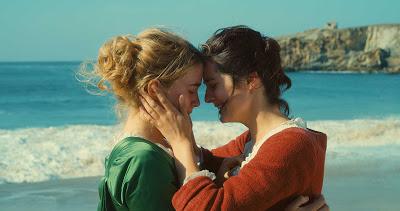
Trust and love blossoms between painter and subject
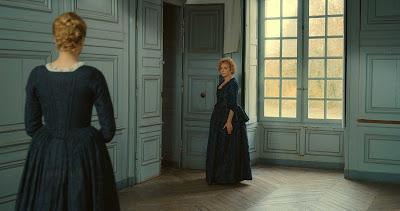
The countess (Valeria Golino) (facing camera) presents
the typical 18th century lady, a lesser developed character of the quartet
Céline Sciamma’s ability as an original script-writer and director brings her in the august company of two other top-notch contemporary female directors: Claire Denis from France (Beau Travail and L’intrus) and Anne Fontaine from Luxembourg (Dry Cleaning). The entire trio have consistently made remarkable films independent of each other.
P.S. Portrait of a Lady on Fire is one the author’s top 20 films of 2019. The film won the Best Screenplay award at the Cannes Film Festival; the Gold Hugo Award for the best feature film at the Chicago International Film Festival; the Rare Pearlaward at the Denver International Film Festival; the Best European Screenwriter Award at the European Film Awards; Art Cinema Award at the Hamburg Film Festival: and the Felix Award for the best fiction film at the Rio de Janeiro International Film Festival. Claire Denis’ film L’intrus (The Intruder) (2004) has been reviewed on this blog earlier.

